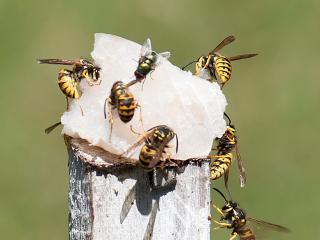Perth residents have been urged to report any sightings of the declared pest European wasp, after three recent discoveries in unexpected locations across the metropolitan area.
The Department of Agriculture and Food has more than 1200 agency and volunteer European wasp traps throughout the city, in high risk areas where the pest is most likely to be detected.
Department senior technical officer Marc Widmer said the recent reports were from just outside the surveillance program’s cross-section of the city, from Lesmurdie, Landsdale and Forrestdale.
Mr Widmer said the public’s reports highlighted the importance of the community’s role in biosecurity.
“If these recent reports were not made, the nests could have matured and released thousands of reproductive queens, which would make the problem even more widespread,” Mr Widmer said.
The department has since found and destroyed the Lesmurdie and Forrestdale nests, while officers are confident they will soon locate the other nest in Landsdale.
There has been a marked decline in the number of European wasp nests this year compared to this time last year, with only 23 confirmed in the metropolitan area to date, compared with 84 nests in 2016.
This year marks 40 years since the department launched its eradication program, and WA remains the only place in the world, within the wasps range, to keep these wasps from establishing for so long.
“We suspect the lower number is due to certain climatic conditions in the eastern states, from where newly fertilised wasp queens come from within imported goods,” Mr Widmer said.
Community surveillance will become even more valuable in coming weeks, as the weather cools and the effectiveness of the lures used in trapping becomes reduced, according to Mr Widmer.
“The high protein lures become less attractive to wasp workers as the colony ages,” he said.
“We encourage the public to remain vigilant and to keep an eye out for European wasps, especially near industrialised areas, and to report any suspected sightings to the department.”
European wasps are similar in shape and size to a common honey bee, but are bright lemon-yellow in colour, with black stripes and yellow legs and black antennae on their heads. They are unique in that they feed on sweet foods and proteins and are attracted to meat, fish, dead insects and pet food.
Mr Widmer said the discoveries were a timely reminder for the public to take care to avoid being stung by a European wasp.
“These wasps are one of the world’s worst social pests, and can cause a nasty or dangerous sting to people, pets and livestock,” he said.
People and organisations interested in supporting European wasp surveillance can join the department’s Adopt-a-Trap program. More information is available on the department’s website agric.wa.gov.au
Any suspected sightings of European wasps should be reported immediately to the department’s Pest and Disease Information Service on freecall 1800 084 881 or use the department’s free MyPestGuide Reporter app.

Media contacts: Jodie Thomson/Megan Broad, media liaison, +61 (0)8 9368 3937
